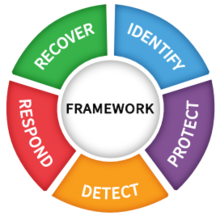https://www.nist.gov/cyberframework/framework
NIST Cybersecurity Framework (CSF) Version 1.1
What is NIST CSF?
First, if you haven’t heard of NIST CSF, you’re definitely going to want to familiarize yourself with it.
The National Institute of Standards and Technology (NIST) Cybersecurity Framework (CSF) is a set of guidelines and best practices to help organizations manage cybersecurity risks. The framework has five functions – Identify, Protect, Detect, Respond, and Recover – which provide a solid foundation for a comprehensive cybersecurity program.
The best thing about the framework is that it’s flexible and customizable. You can adapt it to fit the needs of organizations of all sizes and types, whether they’re businesses, government agencies, or non-profits. By using the NIST Cybersecurity Framework, organizations can tailor a program to their specific needs and priorities, and manage cyber risks over time. So, if you’re new to the cybersecurity field, look into the NIST Cybersecurity Framework as a starting point for building a strong cybersecurity program.
Coming Soon: A new version (2.0) is set to debut in Summer 2023. We’ll link to that when it is available.
How would I use CSF?
Second, there are hundreds of ways to put CSF to work. Below are just a few examples of activities you’ll want to perform from different NIST CSF functions:
- Identify: Conduct a risk assessment to identify potential vulnerabilities and threats to your organization’s assets, systems, and data. Use the results of the assessment to prioritize and allocate resources for cybersecurity.
- Protect: Implement access controls, network segmentation, encryption, and other security measures to protect your organization’s critical assets from cyber threats. Develop policies and procedures that promote secure practices among employees and partners.
- Detect: Implement security monitoring, intrusion detection, and incident response capabilities to detect and respond to cyber threats in real-time. Use automated tools to scan your systems for vulnerabilities and potential threats.
- Respond: Develop an incident response plan that outlines the steps your organization will take in the event of a cyber attack or data breach. Train employees and partners on the plan, and conduct regular drills to ensure readiness.
- Recover: Develop a business continuity plan that outlines how your organization will recover from a cyber attack or other disruptive event. Back up critical data and systems regularly, and test your recovery plan regularly to ensure it’s effective.
The bigger picture
Finally, you can optimize how you use the CSF, or other similar frameworks, by tying as much of your processes to the framework as possible in areas such as these:
- Assess your organization’s overall maturity against the framework and use it to benchmark and plan where you want to be
- Identify what parts of your strategy and in-flight tasks or projects tie to CSF functions and categories
- Map your controls, metrics, and operational reports to the framework
- Introduce the framework and its use to supporters outside of Cybersecurity and to executives to align everyone’s mindset

[…] (NIST) Cybersecurity Framework. The guidance provides a sector-specific interpretation of the NIST Cybersecurity Framework to help energy organizations identify, assess, and manage their cybersecurity […]
[…] NIST Cybersecurity Framework (CSF) is a comprehensive set of guidelines for managing cybersecurity risk in organizations. The NIST CSF […]
[…] NIST 800-53 provides a specific set of security controls for federal information systems, while NIST CSF is a more general framework that can be applied to any organization in any […]
[…] NIST Privacy Framework is often compared to the NIST Cybersecurity Framework (CSF), which is another set of guidelines developed by NIST for managing cybersecurity risks. While […]